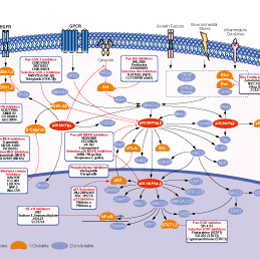
- Bioactive Compounds
- By Signaling Pathways
- PI3K/Akt/mTOR
- Epigenetics
- Methylation
- Immunology & Inflammation
- Protein Tyrosine Kinase
- Angiogenesis
- Apoptosis
- Autophagy
- ER stress & UPR
- JAK/STAT
- MAPK
- Cytoskeletal Signaling
- Cell Cycle
- TGF-beta/Smad
- DNA Damage/DNA Repair
- Compound Libraries
- Popular Compound Libraries
- Customize Library
- Clinical and FDA-approved Related
- Bioactive Compound Libraries
- Inhibitor Related
- Natural Product Related
- Metabolism Related
- Cell Death Related
- By Signaling Pathway
- By Disease
- Anti-infection and Antiviral Related
- Neuronal and Immunology Related
- Fragment and Covalent Related
- FDA-approved Drug Library
- FDA-approved & Passed Phase I Drug Library
- Preclinical/Clinical Compound Library
- Bioactive Compound Library-I
- Bioactive Compound Library-Ⅱ
- Kinase Inhibitor Library
- Express-Pick Library
- Natural Product Library
- Human Endogenous Metabolite Compound Library
- Alkaloid Compound LibraryNew
- Angiogenesis Related compound Library
- Anti-Aging Compound Library
- Anti-alzheimer Disease Compound Library
- Antibiotics compound Library
- Anti-cancer Compound Library
- Anti-cancer Compound Library-Ⅱ
- Anti-cancer Metabolism Compound Library
- Anti-Cardiovascular Disease Compound Library
- Anti-diabetic Compound Library
- Anti-infection Compound Library
- Antioxidant Compound Library
- Anti-parasitic Compound Library
- Antiviral Compound Library
- Apoptosis Compound Library
- Autophagy Compound Library
- Calcium Channel Blocker LibraryNew
- Cambridge Cancer Compound Library
- Carbohydrate Metabolism Compound LibraryNew
- Cell Cycle compound library
- CNS-Penetrant Compound Library
- Covalent Inhibitor Library
- Cytokine Inhibitor LibraryNew
- Cytoskeletal Signaling Pathway Compound Library
- DNA Damage/DNA Repair compound Library
- Drug-like Compound Library
- Endoplasmic Reticulum Stress Compound Library
- Epigenetics Compound Library
- Exosome Secretion Related Compound LibraryNew
- FDA-approved Anticancer Drug LibraryNew
- Ferroptosis Compound Library
- Flavonoid Compound Library
- Fragment Library
- Glutamine Metabolism Compound Library
- Glycolysis Compound Library
- GPCR Compound Library
- Gut Microbial Metabolite Library
- HIF-1 Signaling Pathway Compound Library
- Highly Selective Inhibitor Library
- Histone modification compound library
- HTS Library for Drug Discovery
- Human Hormone Related Compound LibraryNew
- Human Transcription Factor Compound LibraryNew
- Immunology/Inflammation Compound Library
- Inhibitor Library
- Ion Channel Ligand Library
- JAK/STAT compound library
- Lipid Metabolism Compound LibraryNew
- Macrocyclic Compound Library
- MAPK Inhibitor Library
- Medicine Food Homology Compound Library
- Metabolism Compound Library
- Methylation Compound Library
- Mouse Metabolite Compound LibraryNew
- Natural Organic Compound Library
- Neuronal Signaling Compound Library
- NF-κB Signaling Compound Library
- Nucleoside Analogue Library
- Obesity Compound Library
- Oxidative Stress Compound LibraryNew
- Plant Extract Library
- Phenotypic Screening Library
- PI3K/Akt Inhibitor Library
- Protease Inhibitor Library
- Protein-protein Interaction Inhibitor Library
- Pyroptosis Compound Library
- Small Molecule Immuno-Oncology Compound Library
- Mitochondria-Targeted Compound LibraryNew
- Stem Cell Differentiation Compound LibraryNew
- Stem Cell Signaling Compound Library
- Natural Phenol Compound LibraryNew
- Natural Terpenoid Compound LibraryNew
- TGF-beta/Smad compound library
- Traditional Chinese Medicine Library
- Tyrosine Kinase Inhibitor Library
- Ubiquitination Compound Library
-
Cherry Picking
You can personalize your library with chemicals from within Selleck's inventory. Build the right library for your research endeavors by choosing from compounds in all of our available libraries.
Please contact us at info@selleckchem.com to customize your library.
You could select:
- Antibodies
- Bioreagents
- qPCR
- 2x SYBR Green qPCR Master Mix
- 2x SYBR Green qPCR Master Mix(Low ROX)
- 2x SYBR Green qPCR Master Mix(High ROX)
- Protein Assay
- Protein A/G Magnetic Beads for IP
- Anti-Flag magnetic beads
- Anti-Flag Affinity Gel
- Anti-Myc magnetic beads
- Anti-HA magnetic beads
- Poly DYKDDDDK Tag Peptide lyophilized powder
- Protease Inhibitor Cocktail
- Protease Inhibitor Cocktail (EDTA-Free, 100X in DMSO)
- Phosphatase Inhibitor Cocktail (2 Tubes, 100X)
- Cell Biology
- Cell Counting Kit-8 (CCK-8)
- Animal Experiment
- Mouse Direct PCR Kit (For Genotyping)
- New Products
- Contact Us
Adezmapimod (SB203580)
p38 MAPK inhibitor
research use only
Adezmapimod (SB203580, RWJ 64809, PB 203580) is a p38 MAPK inhibitor with IC50 of 0.3-0.5 μM in THP-1 cells, 10-fold less sensitive to SAPK3(106T) and SAPK4(106T) and blocks PKB phosphorylation with IC50 of 3-5 μM. SB203580 induces mitophagy and autophagy.
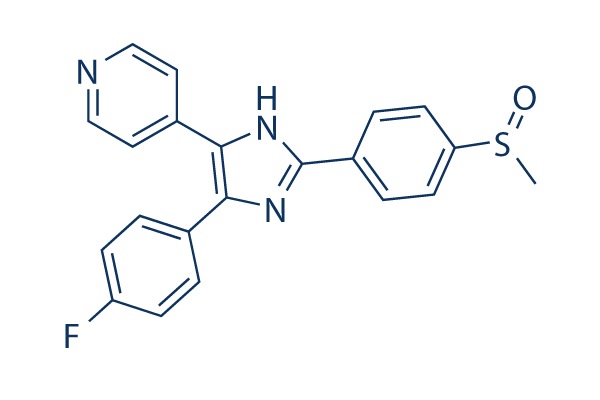
Adezmapimod (SB203580) Chemical Structure
Molecular Weight: 377.43
Purity & Quality Control
Batch:
Purity:
99.98%
99.98
Adezmapimod (SB203580) Related Products
| Related Targets | p38α p38β | Click to Expand |
|---|---|---|
| Related Products | SB202190 Doramapimod (BIRB 796) Ralimetinib (LY2228820) dimesylate PH-797804 VX-702 Losmapimod SB239063 Neflamapimod (VX-745) BMS-582949 Skepinone-L Asiatic Acid TAK-715 Pamapimod Pexmetinib SD 0006 R1487 PD 169316 | Click to Expand |
| Related Compound Libraries | Kinase Inhibitor Library MAPK Inhibitor Library Cell Cycle compound library TGF-beta/Smad compound library Anti-alzheimer Disease Compound Library | Click to Expand |
Signaling Pathway
Cell Culture and Working Concentration
| Cell Lines | Assay Type | Concentration | Incubation Time | Formulation | Activity Description | PMID |
|---|---|---|---|---|---|---|
| PC12 | Kinase Assay | 10 μM | 15 min | Inhibits p38 MAP kinase with IC50 of 0.6 μM | 7750577 | |
| THP-1 | Function Assay | Inhibits LPS-induced TNFalpha production with IC50 of 0.16 μM | 18325768 | |||
| PBMC | Function Assay | 15 min | DMSO | Inhibits the release of interleukin-1-beta with IC50 of 0.037 μM | 12361396 | |
| SW1353 | Function Assay | 1 h | DMSO | Inhibits IL-6 production with IC50 of 0.05 μM | 11140741 | |
| Hela | Function Assay | DMSO | Inhibits Tat-induced HIV1 LTR transactivation in human HeLa cells with IC50 of 0.1 μM | 18926711 | ||
| PC12 | Function Assay | 10 μM | DMSO | Activates Nrf2/ARE in rat PC12 cells assessed as HO-1 protein induction | 21345685 | |
| RAW 264.7 | Cytotoxic Assay | 12.5 μM | 12h | DMSO | Blocks lethal toxin-mediated cytotoxicity | 17485504 |
| HCA2 | Function Assay | 2.5 μM | Inhibits p38 mediated MK2 activation | 17964780 | ||
| U937 | Function Assay | Inhibits JAK-mediated interferon-gamma/anisomycin-induced Stat1 phosphorylation | 18157122 | |||
| U937 | Function Assay | Inhibits JAK-mediated interferon-gamma/anisomycin-induced p38 phosphorylation | 18157122 | |||
| hESCs | Growth Inhibition Assay | 5 μM | DMSO | Induces cardiomyogenic activity assessed as cell growth | 23602399 | |
| RAW264.7 | Function Assay | 10 μM | Induces antiinflammatory activity by inhibiting IL-1β release | 23791078 | ||
| RAW264.7 | Function Assay | 10 μM | Induces antiinflammatory activity by inhibiting iNOS release | 23791078 | ||
| RAW264.7 | Function Assay | 10 μM | Induces antiinflammatory activity by inhibiting NO release | 23791078 | ||
| RAW264.7 | Function Assay | 10 μM | Inhibits LPS-induced p38 MAPK phosphorylation | 24016057 | ||
| IEC-18 | Function Assay | 10 μM | Inhibits LPS-induced p38 MAPK phosphorylation | 23758110 | ||
| Sf9 | Function assay | 30 mins | Inhibition of full-length FLAG-6His-TEV tagged human RIP2 expressed in Sf9 cells assessed as reduction in autophosphorylation pre-incubated for 30 mins followed by incubation with ATP for 2 hrs by ADP-Glo assay, IC50 = 0.01 μM. | 26455654 | ||
| sf21 | Function assay | Binding affinity to wild type human biotin labelled p38 alpha (9 to 352 residues) expressed in sf21 insect cells SPR analysis, Kd = 0.0217 μM. | 28834431 | |||
| PBMC | Function assay | Inhibition of TNF-alpha production by lipopolysaccharide-stimulated human peripheral blood mononuclear cells, IC50 = 0.025 μM. | 9873730 | |||
| PBMC | Function assay | Inhibition of LPS-stimulated TH+NF-alphs production by human peripheral blood mononuclear cells (PBMCs), IC50 = 0.025 μM. | 9784093 | |||
| PBMC | Function assay | Inhibition of p38 MAP kinase related TNF-alpha release from peripheral blood mononuclear cells (PBMC), IC50 = 0.037 μM. | 12061876 | |||
| PBMC | Function assay | Inhibition of LPS-induced IL1-beta production in human peripheral blood mononuclear cells(PBMCs), IC50 = 0.048 μM. | 9784093 | |||
| SW1353 | Function assay | Compound was evaluated for its ability to inhibit IL-6 production in SW1353 cells treated with cytokines IL-1 and TNF, IC50 = 0.05 μM. | 10999467 | |||
| SW1353 | Function assay | Inhibition of TNF and IL-1 induced IL-6 production in human chondro-sarcoma SW 1353 cells, IC50 = 0.05 μM. | 10999468 | |||
| THP1 | Function assay | Inhibition of LPS-stimulated IL1 production in human THP1 cells, IC50 = 0.05 μM. | 18077363 | |||
| THP1 | Function assay | Inhibition of LPS-stimulated TNFalpha production in human THP1 cells, IC50 = 0.05 μM. | 18077363 | |||
| THP1 | Function assay | Inhibition of LPS-induced tumor necrosis factor-alpha (TNF-alpha) production in THP-1 cells, EC50 = 0.06 μM. | 12086485 | |||
| THP1 | Function assay | Inhibition of tumor necrosis factor alpha release by THP-1 cells, IC50 = 0.07 μM. | 15658855 | |||
| monocytic cell | Function assay | Inhibitory activity against TNF-alpha production using lipopolysaccharide stimulated human monocytic cells, IC50 = 0.072 μM. | 12729637 | |||
| THP1 | Function assay | Inhibitory activity against LPS-stimulated TNF-alpha production in human monocytic cells (THP-1), IC50 = 0.072 μM. | 15139749 | |||
| THP-1 | Function assay | Inhibitory activity against lipopolysaccharide stimulated TNF-alpha production in THP-1 cells (human monocytic cells), IC50 = 0.072 μM. | 15837310 | |||
| THP1 | Function assay | Inhibition of LPS-stimulated TNFalpha production in THP1 cells, IC50 = 0.072 μM. | 16750367 | |||
| PBMC | Function assay | Inhibition of staphylococcal enterotoxin B(SEB) stimulated tumor necrosis factor alpha (TNF-alpha) production by human peripheral blood mononuclear cells(PBMCs), IC50 = 0.16 μM. | 9784093 | |||
| PBMC | Function assay | Concentration required to inhibit lipopolysaccharide induced TNF-alpha release was determined in human peripheral blood mononuclear cells, IC50 = 0.19 μM. | 15454231 | |||
| Sf9 | Function assay | Inhibition of full-length FLAG-6His-TEV tagged human RIP2 expressed in Sf9 cells by fluorescent polarization assay, IC50 = 0.2 μM. | 26455654 | |||
| HEK293F | Function assay | Inhibition of sodium arsenate activated N-terminal GST-tagged Brugia malayi MPK1 expressed in HEK293F cells using FAM-p38tide as substrate by IMAP assay, IC50 = 0.22 μM. | 29541362 | |||
| HEK-293 | Function assay | Inhibition of RIP2K in MDP-stimulated HEK-293 cells over-expressing NOD2 assessed as IL8 secretion, IC50 = 0.25 μM. | 27109867 | |||
| whole blood cell | Function assay | 0.01 to 100 uM | Inhibition of p38-related IL1-beta release by whole blood cells at 10 e-4 to 10 e-8 M, IC50 = 0.35 μM. | 12852754 | ||
| PBMC | Function assay | Inhibition of p38 MAP kinase related TNF-alpha release from peripheral blood mononuclear cells (PBMC), IC50 = 0.59 μM. | 12061876 | |||
| PBMC | Function assay | Inhibition of the release of tumor necrosis factor alpha from peripheral blood mononuclear cells, IC50 = 0.59 μM. | 12361396 | |||
| PBMC | Function assay | Inhibitory activity against TNF-alpha release in PBM cells, IC50 = 0.59 μM. | 12852754 | |||
| whole blood cell | Function assay | 0.01 to 100 uM | Inhibition of p38-related TNF-alpha release by whole blood cells at 10 e-4 to 10 e-8 M, IC50 = 0.94 μM. | 12852754 | ||
| BMDC | Antiinflammatory assay | 1 hr | Antiinflammatory activity in C57BL/6 mouse BMDC cells assessed as inhibition of LPS-induced IL-6 production preincubated for 1 hr prior to LPS-stimulation measured after 18 hrs by ELISA, IC50 = 3.5 μM. | 24047259 | ||
| BMDC | Antiinflammatory assay | 1 hr | Antiinflammatory activity in C57BL/6 mouse BMDC cells assessed as inhibition of LPS-induced IL-12 p40 production preincubated for 1 hr prior to LPS-stimulation measured after 18 hrs by ELISA, IC50 = 5 μM. | 24047259 | ||
| HEK-293 | Function assay | Inhibition of RIP2K in Pam2CSK4-stimulated HEK-293 cells over-expressing TLR2 assessed as IL8 secretion, IC50 = 6.31 μM. | 27109867 | |||
| BMDC | Antiinflammatory assay | 1 hr | Antiinflammatory activity in C57BL/6 mouse BMDC cells assessed as inhibition of LPS-induced TNFalpha production preincubated for 1 hr prior to LPS-stimulation measured after 18 hrs by ELISA, IC50 = 7.5 μM. | 24047259 | ||
| macrophage-like cell | Antiinflammatory assay | 30 mins | Antiinflammatory activity in human HL-60 derived macrophage-like cells assessed as inhibition of LPS-induced TNFalpha production treated 30 mins before LPS stimulation measured after 24 hrs by ELISA, IC50 = 8.6 μM. | 23811089 | ||
| WS | Function assay | 2.5 uM | Inhibition of anisomycin-induced P38-alpha activation in human human TERT-immortalised WS cells assessed as HSP27 phosphorylation at 2.5 uM | 17659871 | ||
| WS | Function assay | Inhibition of MK2 mediated HSP27 phosphorylation in immortalised WS cells assessed as reduction in F-actin stress fibres | 17964780 | |||
| WS | Function assay | Inhibition of p38 mediated MK2 activation in WS cells | 17964780 | |||
| A673 | qHTS assay | qHTS of pediatric cancer cell lines to identify multiple opportunities for drug repurposing: Primary screen for A673 cells | 29435139 | |||
| Saos-2 | qHTS assay | qHTS of pediatric cancer cell lines to identify multiple opportunities for drug repurposing: Primary screen for Saos-2 cells | 29435139 | |||
| BT-37 | qHTS assay | qHTS of pediatric cancer cell lines to identify multiple opportunities for drug repurposing: Primary screen for BT-37 cells | 29435139 | |||
| RD | qHTS assay | qHTS of pediatric cancer cell lines to identify multiple opportunities for drug repurposing: Primary screen for RD cells | 29435139 | |||
| BT-12 | qHTS assay | qHTS of pediatric cancer cell lines to identify multiple opportunities for drug repurposing: Primary screen for BT-12 cells | 29435139 | |||
| OHS-50 | qHTS assay | qHTS of pediatric cancer cell lines to identify multiple opportunities for drug repurposing: Primary screen for OHS-50 cells | 29435139 | |||
| SJ-GBM2 | qHTS assay | qHTS of pediatric cancer cell lines to identify multiple opportunities for drug repurposing: Primary screen for SJ-GBM2 cells | 29435139 | |||
| SK-N-MC | qHTS assay | qHTS of pediatric cancer cell lines to identify multiple opportunities for drug repurposing: Primary screen for SK-N-MC cells | 29435139 | |||
| Click to View More Cell Line Experimental Data | ||||||
Mechanism of Action
| Description | Adezmapimod (SB203580, RWJ 64809, PB 203580) is a p38 MAPK inhibitor with IC50 of 0.3-0.5 μM in THP-1 cells, 10-fold less sensitive to SAPK3(106T) and SAPK4(106T) and blocks PKB phosphorylation with IC50 of 3-5 μM. SB203580 induces mitophagy and autophagy. | ||||
|---|---|---|---|---|---|
| Features | First reported p38 inhibitor. | ||||
| Targets |
|
In vitro |
||||
| In vitro | SB203580 inhibits the IL-2-induced proliferation of primary human T cells, murine CT6 T cells, or BAF F7 B cells with an IC50 of 3–5 μm. SB203580 also inhibits IL-2-induced p70S6 kinase activation, although the concentration required is slightly higher with an IC50 above 10 μm. SB203580 also inhibits the activity of PDK1 in a dose-dependent manner with an IC50 in the 3–10 μm range. [1] SB203580 inhibits p38-MAPK stimulation of MAPKAPK2 with an IC50 of approximately 0.07 μM, whereas inhibits total SAPK/JNK activity with an IC50 of 3–10 μM. SB203580 at higher concentrations activates the ERK pathway, which subsequently enhances NF-κB transcriptional activity. [2] SB203580 induces autophagy in human hepatocellular carcinoma (HCC) cells. [3] |
|||
|---|---|---|---|---|
| Kinase Assay | Cellular receptor kinase phosphorylation assay | |||
| 4 μg of sheep anti-PKBα is immobilized on 25 μL of protein G-Sepharose overnight (or 1.5 hours) and washed in Buffer A (50 mm Tris, pH 7.5, 1 mm EDTA, 1 mm EGTA, 0.5 mm Na3VO4, 0.1% β-mercaptoethanol, 1% Triton X-100, 50 mm sodium fluoride, 5 mm sodium pyrophosphate, 0.1 mm phenylmethylsulfonyl fluoride, 1 μg/mL pepstatin, leupeptin, and 1 μm microcystin). The immobilized anti-PKB is then incubated with 0.5 ml of lysate (from 5 × 106 cells) for 1.5 hours and washed three times in 0.5 mL of Buffer A supplemented with 0.5 m NaCl, two times in 0.5 mL of Buffer B (50 mm Tris-HCl, pH 7.5, 0.03% (w/v) Brij-35, 0.1 mm EGTA, and 0.1% β-mercaptoethanol), and twice with 100 μl of assay dilution buffer; 5× assay dilution buffer is 100 mm MOPS, pH 7.2, 125 mm β-glycerophosphate, 25 mm EGTA, 5 mm sodium orthovanadate, 5 mm DTT. To the PKB enzyme immune complex is added 10 μL of assay dilution buffer, 40 μm protein kinase A inhibitor peptide, 100 μm PKB-specific substrate peptide, and 10 μCi of [γ-32P]ATP, all made up in assay dilution buffer. The reaction is incubated for 20 minutes at room temperature with shaking, then samples are pulse spun, and 40 μL of reaction volume are removed into another tube to which is added 20 μL of 40% trichloroacetic acid to stop the reaction. This is mixed and incubated for 5 minutes at room temperature, and 40 μL is transferred onto P81 phosphocellulose paper and allowed to bind for 30 seconds. The P81 piece is washed three times in 0.75% phosphoric acid then in acetone at room temperature. γ-32P incorporation is then measured by scintillation counting. | ||||
| Cell Research | Cell lines | CT6 cell , BA/F3 F7 cell | ||
| Concentrations | 0–30 μM | |||
| Incubation Time | 1 hour | |||
| Method | CT6 cell and BA/F3 F7 cell are rested by washing three times in RPMI and culturing overnight in RPMI, 5% fetal calf serum in the absence of growth factor, antibiotics, or β-mercaptoethanol supplements. 2–5 × 106 rested CT6 cells are resuspended in 2 mL of RPMI, 5% fetal calf serum and preincubated with SB203580 or vehicle control as indicated in figure legends. Cells are then stimulated with 20 ng/ml recombinant human IL-2 for 5 minutes at 37 °C and pelleted in a minifuge for 30 seconds, medium is aspirated, and the pellet is lysed in the appropriate buffer. BA/F3 cells stably expressing deletion mutants of IL-2 receptor β chain are maintained in glutamine containing RPMI further supplemented with 5% fetal calf serum and 0.2 μg/mL G418. The cells are then washed extensively, rested overnight, and washed again before activating with IL-2; such cell preparations are >90% T cells. Cellular proliferation assays are performed by measurement of [3H]thymidine incorporation. |
|||
| Experimental Result Images | Methods | Biomarkers | Images | PMID |
| Western blot | phospho-p38 / p38 p-ASK1 / ASK1 / P-JNK / p-MKK4 / p-ERK phospho-MK2(T334) / phospho-HSP27(S82) / phospho-Akt(T308) / phospho-Akt(S473) |
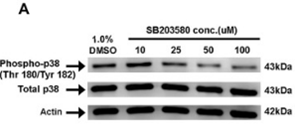
|
25747578 | |
| Immunofluorescence | dsRNA / hnRNP A1 |
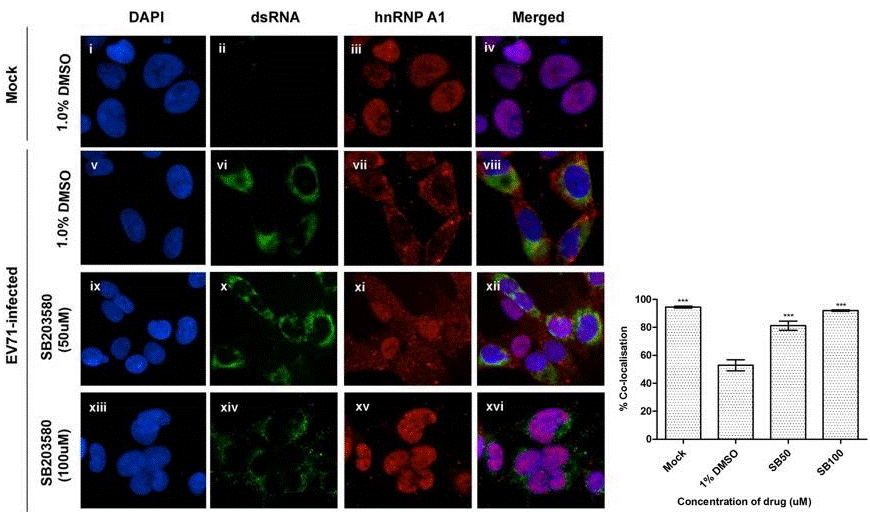
|
25747578 | |
| Growth inhibition assay | Cell viability |
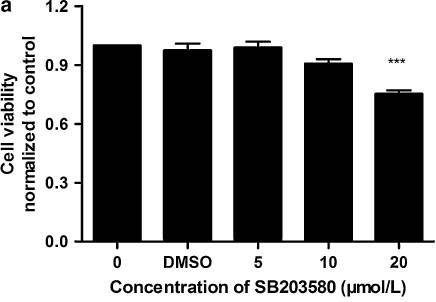
|
23001390 | |
In Vivo |
||
| In vivo | SB203580 protects pig myocardium against ischemic injury in an in vivo model. [4]SB203580 is effective to prevent and treat the disease in MRL/lpr mice model of Systemic lupus erythematosus (SLE). [5] |
|
|---|---|---|
| Animal Research | Animal Models | Systemic lupus erythematosus (SLE) are established in female MRL/lpr mice and female C57BL/6 mice |
| Dosages | 0.1 M/day | |
| Administration | Orally administered | |
References |
|
Chemical Information
| Molecular Weight | 377.43 | Formula | C21H16FN3OS |
| CAS No. | 152121-47-6 | SDF | Download Adezmapimod (SB203580) SDF |
| Synonyms | RWJ 64809, PB 203580 | ||
| Smiles | CS(=O)C1=CC=C(C=C1)C2=NC(=C(N2)C3=CC=NC=C3)C4=CC=C(C=C4)F | ||
Storage and Stability
| Storage (From the date of receipt) | 3 years -20°C(in the dark) powder | ||
|
In vitro |
DMSO : 38 mg/mL ( (100.68 mM) Moisture-absorbing DMSO reduces solubility. Please use fresh DMSO.) Water : Insoluble Ethanol : Insoluble |
Molecular Weight Calculator |
|
In vivo Add solvents to the product individually and in order. |
In vivo Formulation Calculator |
|||||
Preparing Stock Solutions
Molarity Calculator
In vivo Formulation Calculator (Clear solution)
Step 1: Enter information below (Recommended: An additional animal making an allowance for loss during the experiment)
mg/kg
g
μL
Step 2: Enter the in vivo formulation (This is only the calculator, not formulation. Please contact us first if there is no in vivo formulation at the solubility Section.)
% DMSO
%
% Tween 80
% ddH2O
%DMSO
%
Calculation results:
Working concentration: mg/ml;
Method for preparing DMSO master liquid: mg drug pre-dissolved in μL DMSO ( Master liquid concentration mg/mL, Please contact us first if the concentration exceeds the DMSO solubility of the batch of drug. )
Method for preparing in vivo formulation: Take μL DMSO master liquid, next addμL PEG300, mix and clarify, next addμL Tween 80, mix and clarify, next add μL ddH2O, mix and clarify.
Method for preparing in vivo formulation: Take μL DMSO master liquid, next add μL Corn oil, mix and clarify.
Note: 1. Please make sure the liquid is clear before adding the next solvent.
2. Be sure to add the solvent(s) in order. You must ensure that the solution obtained, in the previous addition, is a clear solution before proceeding to add the next solvent. Physical methods such
as vortex, ultrasound or hot water bath can be used to aid dissolving.
Tech Support
Answers to questions you may have can be found in the inhibitor handling instructions. Topics include how to prepare stock solutions, how to store inhibitors, and issues that need special attention for cell-based assays and animal experiments.
Tel: +1-832-582-8158 Ext:3
If you have any other enquiries, please leave a message.
* Indicates a Required Field






































